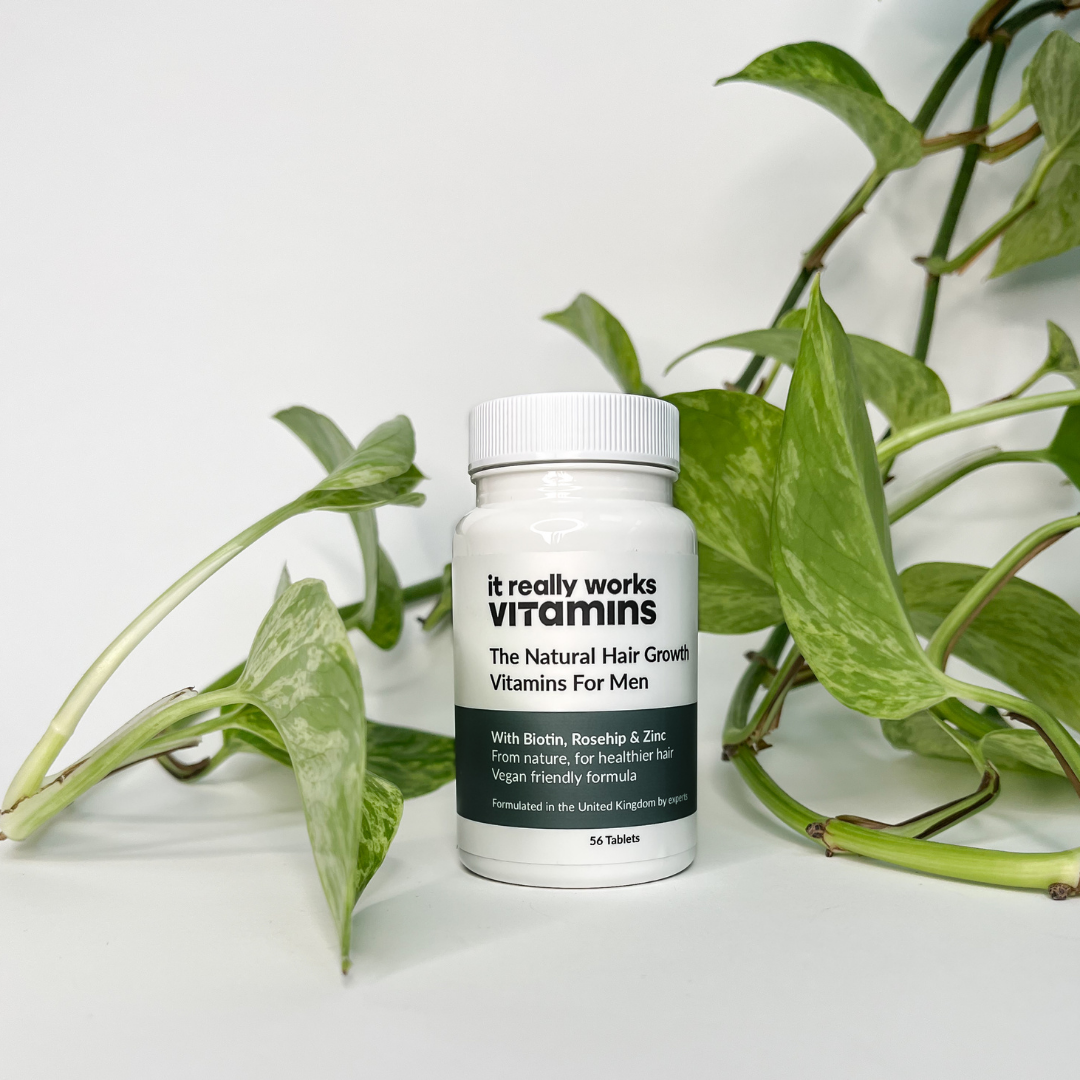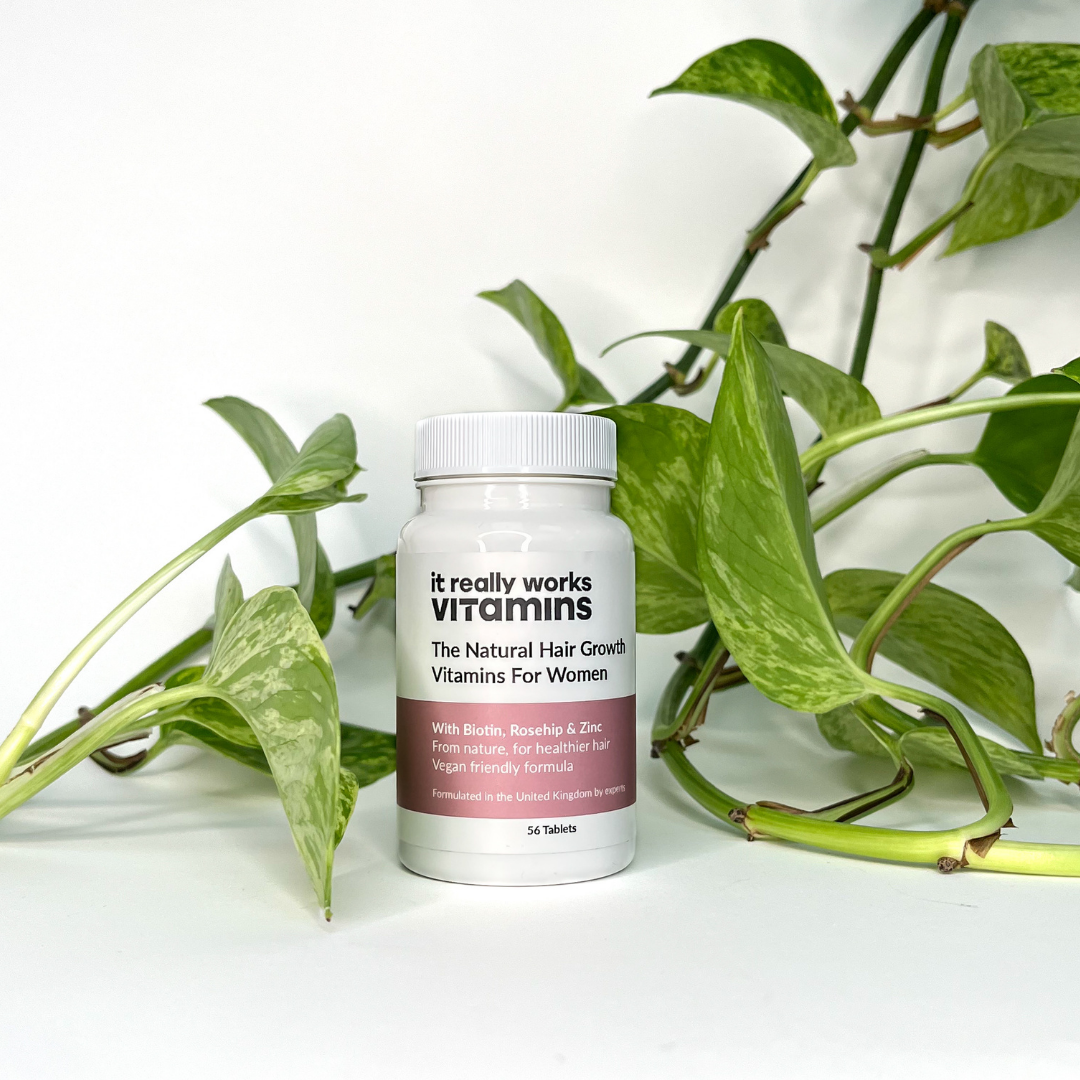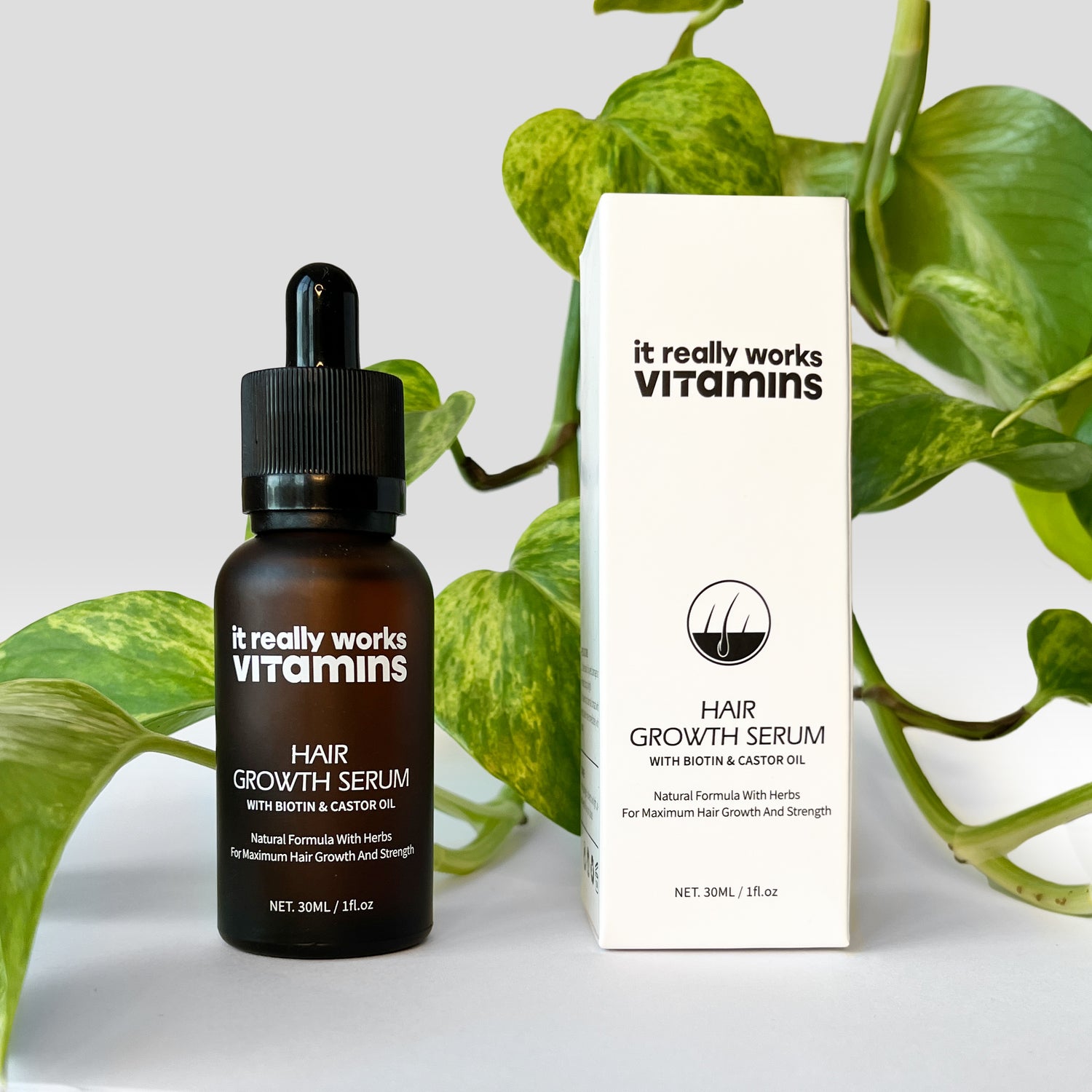Welcome back to the It Really Works Vitamins blog!
If you're looking for the best ways to remove DHT from the scalp then you're in the right place.
Chances are you're one of the 50% of all guys, worldwide, currently experiencing hair loss. Hair thinning can be down to a variety of reasons including poor diet, stress, and hereditary hair loss otherwise known as androgenic alopecia.
Worldwide, male and female pattern hair loss affects the lives of 30 million women and 50 million. Women have lower levels of testosterone and the interaction of enzymes and hormones can lead to female pattern baldness, although this is not entirely understood by scientists.
Androgenic Alopecia in men is believed to be due to a combination of genetics and the male hormone dihydrotestosterone or DHT. DHT is a naturally occurring hormone, formed in the prostate.
When increased amounts of DHT are present on the scalp, they attach themselves to Androgen Receptors on your hair follicles and over time this causes hair follicles to miniaturise and eventually disappear.
By the age of 50 years, over half of the men in the U.S. will probably experience hair loss brought on by DHT.
In today's blog we check out treatments that can block DHT and in doing so help to hold back hair loss!
1. DHT Blocking Shampoos
What ingredients should I look for in a DHT Blocking Shampoo?
- Zinc
- Saw Palmetto
- Flax
- Sesame
- Pumpkin seeds
- Nettle extract
- Biotin
- Salycilic Acid
- Azelic Acid
- Aloe Vera
- Ketoconazole

A good quality DHT-blocking shampoo will help to gently lift DHT from your scalp. Check the ingredients label and look out for key natural DHT-blocking nutrients including zinc which helps to stop the build up of DHT and Saw Palmetto, which also assists in slowing down DHT production. Other helpful ingredients are Flax, Sesame, Pumpkin seeds, Nettle extract, Biotin, Salycilic Acid, Azelic Acid and Aloe Vera and vitamin B12 to promote healthy hair growth.
A particular chemical ingredient that is proven to work well is ketoconazole.

Ketoconazole is an antifungal medication which is primarily used to treat fungal infections. This very small pilot study made up of fifteen people with alopecia, for example, found that Ketoconazole may be able to improve hair regrowth.
Do be aware that in some cases Ketoconazole can have uncomfortable side effects. One of the most common side effects is skin irritations, in particular pimple-like bumps where the skin has come into contact with Ketoconazole. In some individuals, it may also cause either oiliness or dryness of the hair or scalp, abnormal hair texture, or discoloration. Also, do be aware that if you've had your hair permed, Ketoconazole can take away the curls.
2. Finasteride and Minoxidil
Finasteride (also known as Propecia) and Minoxidil have become popular drugs in the fight against hair loss.
Minoxidil and Finasteride have both been approved by The FDA as treatments for hair loss. Minoxidil is a topical solution that is rubbed on the scalp and finasteride is a pill taken orally.
"The use of Finasteride which blocks androgen production at its source and therefore lowers local scalp DHT, is likely the gold standard in delaying true genetic male pattern hair loss," says Dr R. Stephen Mullholland MD.

Some Finasteride and Minoxidil users have also found that their hair loss may get worse before it gets better. These medicines are prescription only and so after receiving these treatments from your doctor, it's a good idea to check in with them if you are concerned about a greater degree of a hair loss than expected.
However, do be aware that like most medicines, these treatments don't come without side effects.
Research published in the Journal of Sexual Medicine reveals that Finasteride can cause:
- Persistent intimate dysfunction including:
- Lowered sexual desire,
- Erectile dysfunction and
- Difficulties with orgasms.
Other side effects include:
- Decreased ejaculatory volume
- Penile shrinkage
- Itchy scalp
3. Lemon Juice and Charcoal Scalp Scrub
Let's talk through a natural exfoliant widely known to help remove DHT from the scalp. As DHT is present on the scalp, the first step is to scrub the scalp with a gentle exfoliate.
This natural scrub is tough enough to remove DHT, sebum, flaking dry skin cells, hair products and any pollutants but gentle enough so as not to damage your hair follicles or scalp.
You will need:
- A blender or juicer.
- Plastic bottle
- Plastic Funnel
And here's your shopping list:
- One whole lemon
- Sea salt
- Powdered activated charcoal
- Ginger
- Cucumber
Take the juice of 1 whole lemon and blend with the entire cucumber. Add around 100g of ginger and half a tablespoon of the salt. and 1 teaspoon of powdered activated charcoal. There's no need to add water, but if the mixture has turned
Sift the mixture through a sieve or muslin.
Using your plastic funnel, add this mixture to your plastic bottle and give it a vigorous shake until it's well-mixed.
Now you're going to need at least 10 minutes to spare.
Apply the mixture to the area of your scalp that you feel is affected by DHT. Gently massage this exfoliant in and leave the mixture to work its magic on the scalp for ten to fifteen minutes.
Rinse the mixture out with warm (not hot) water.
It's a good idea to do this natural scalp scrub once per week and within a month you're likely to notice a real different.
4. Hair Vitamins That Block DHT
Hair vitamins can work to increase blood flow to the scalp, healthy circulation in this area helps to avoid the build up of DHT. When looking for the best hair vitamins to block DHT, take a closer look at the active ingredients.
Vitamin B3 or Niacin, can be found in mushrooms, fish oils, avocado, liver and seeds. Niacin has fantastic anti-inflammatory properties and helps to reverse hair follicle miniaturisation. Moreover, Niacin helps to ensure healthy blood flow to the scalp. This is important as when circulation is restricted around the scalp, this reduces the likelihood of a healthy scalp and is an environment not conducive to hair growth. This study found that men experiencing early Male-Pattern Baldness had subcutaneous blood flow that was 2.6 times less than guys not facing hereditary hair loss. Damn.
It Really Works Vitamins are packed with 145% of your daily recommended allowance of Niacin and if you don't have healthier, thicker hair within 90 days, this hair vitamins brand will refund you.
At this point it's also a good idea to mention our old friend Biotin. Although Biotin doesn't block DHT, Biotin's function in protein synthesis and more specifically, in keratin production, explains its contribution to healthy nail and hair growth. Biotin rich foods include eggs, tuna, berries, legumes and wheat.
Don't forget that It Really Works Vitamins contain a whopping 800% of your recommended intake of Biotin, just enough to ensure healthy, optimal hair growth, but not too much to cause side effects including excess sebum and acne.
5. DHT Blocking Foods
If you're serious about blocking DHT then you're going to need to start packing your diet with the right nutrition. The vitamins and minerals found in these foods alongside the natural scalp scrub we shared above are likely to bring about a real difference in hair loss especially in early onset Androgenic Alopecia.
Lycopene is a powerful antioxidant and the bright red chemical compound found in watermelons, tomatoes, carrots mangoes, papayas and gac.
Lycopene breaks down 5 alpha reductase, the enzyme responsible for turning testosterone into DHT. In this way the humble watermelon inhibits DHT. Neat.
Also, why not try adding sesame seeds to your salads, soups or smoothies, these nifty seeds also play a mean role in inhibiting 5 alpha reductase. Sesame seed oil is also just as good.
Zinc: Zinc is an essential trace mineral which metabolizes vitamins, maintains your immune system and helps to grow and repair body tissues. Your body is unable to store zinc, to it's important to eat the recommended daily allowance of 40 mg per day.
An extreme zinc deficiency can cause hair loss. Although this is rare, zinc deficiencies are most commonly found in Vegetarians. This is because, according to The US National Institute of Health Professionals while zinc is present in plant-based foods, so are antioxidant compounds that attach themselves to zinc and prevent it's effective absorption. As a result, plant-based sources of zinc, including white mushrooms, whole grains, legumes, and nuts, aren't actually a useful source of zinc.
Red meat is a great source of Zinc. A 100-gram serving of raw ground beef provides men with 43% of their daily recommended zinc intake. (Also red meat is a helpful other vital nutrients, such as creatine, iron and B vitamins.
A good way to get Zinc into your diet is to take It Really Works Vitamins
L-Lysine:
Almonds, walnuts, peanuts, pecans: Are rich in L-lysine which is a natural DHT inhibitor. Research shows that L-lysine boosts our bodies natural DHT blockers, enhancing their effectiveness. L-lysine also helps the body absorb iron from the foods you've eaten. Iron helps to nourish your scalp and hair follicles.

6.Natural Oils
As well as packing your diet with foods rich in Lyposene, zinc and L-lysine, you may also want to try massaging these natural oils into your scalp. Various studies reveal how surprisingly effective natural oils can be.
Lavender Oil: This study on animals found that lavender oil generated faster hair growth in mice. Lavender oil is also rich in antibacterial properties that help to clear and prevent fungal conditions on the scalp, great for getting rid of that pesky DHT!
Rosemary Oil is made from rosemary, an aromatic periwinkle shrub with fragrant, needle-like leaves and flowers. Rosemary belongs to the mint family (lamiaceae) and is native to the Mediterranean region. The oil is a popular natural remedy known for its healing properties and relaxing, fragrant scent. In 2015 a team of Iranian researchers found in this study that Rosemary oil produced an increase in hair growth similar to minoxidil over the course of six months.
Patients in the rosemary group also experienced less side effects compared to the minoxidil group.

Peppermint Oil is derived from a plant native to Europe.
Massaging Peppermint Oil into the scalp can increase blood circulation to the scalp. The act of massaging the scalp is great for encouraging blood flow, vivifying hair follicles and promoting healthy hair growth. Peppermint oil also helps to cleanse and open up blocked pores.
In 2014, Korean researchers studied the effects of Peppermint oil on hair growth compared to Minoxidil, Jojoba Oil and Saline. Moreover, compared to Minoxidil, Peppermint Essential Oil was found to have achieved 60% more hair growth than Minoxidil.
Pumpkin seed oil, for example, has been studied by researchers and found to increase mean hair count by as much as 40% over the course of 24 weeks.

Tea Tree Oil: This antimicrobial and anti-fungal can help to unclog hair follicles, heal scalp conditions such as dandruff and nourish roots. Tea tree oil also has anti-androgenic properties, which can block and reduce DHT production.
So there you have it, a complete breakdown of the 6 absolute best ways to remove DHT from the scalp. Which ones have you tried and how did it go? Please leave your comment below. Are there any other topics you'd like us to explore? Comment below and see you next time :)
Try It Really Works Vitamins for strong and healthy hair growth!




